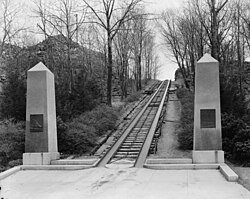Granite Railway
| Quincy Granite Railway | |
|---|---|
| Commercial operations | |
| Original gauge | 5 ft (1,524 mm) |
| Preserved operations | |
| Preserved gauge | 5 ft (1,524 mm) |
| Preservation history | |
|
Quincy Granite Railway Incline
|
|

The Incline section of the Granite Railway
Quincy (1934 photo) |
|
| Location | Mullin Ave., Quincy, Massachusetts |
|---|---|
| Coordinates | 42°14′43″N 71°2′14″W / 42.24528°N 71.03722°WCoordinates: 42°14′43″N 71°2′14″W / 42.24528°N 71.03722°W |
| Area | 0.2 acres (0.08 ha) |
| Built | 1826 |
| NRHP Reference # | |
|
Quincy Granite Railway
|
|
| Location | Bunker Hill Lane, Quincy, Massachusetts |
| Coordinates | 42°14′23″N 71°1′57″W / 42.23972°N 71.03250°W |
| Area | 0.7 acres (0.3 ha) |
| Built | 1826 |
| NRHP Reference # | 73000309 |
| Added to NRHP | October 15, 1973 |
| Added to NRHP | June 19, 1973 |
The Granite Railway was one of the first railroads in the United States, built to carry granite from Quincy, Massachusetts to a dock on the Neponset River in Milton. From there boats carried the heavy stone to Charlestown for construction of the Bunker Hill Monument. The Granite Railway is popularly termed the first commercial railroad in the United States, as it was the first chartered railway to evolve into a common carrier without an intervening closure. The last active quarry closed in 1963; in 1985, the Metropolitan District Commission purchased 22 acres (8.9 ha), including Granite Railway Quarry, as the Quincy Quarries Reservation.
In 1825, after an exhaustive search throughout New England, Solomon Willard selected the Quincy site as the source of stone for the Bunker Hill Monument. After many delays and much obstruction, the railway itself was granted a charter on March 4, 1826, with right of eminent domain to establish its right-of-way. Businessman and state legislator Thomas Handasyd Perkins organized the financing of the new Granite Railway Company, owning a majority of its shares, and he was designated its president. The railroad was designed and built by railway pioneer Gridley Bryant and began operations on October 7, 1826. Bryant used developments that had already been in use on the railroads in England, but he modified his design to allow for heavier, more concentrated loads and a three-foot frost line.
...
Wikipedia


